WordPress database error: [Got error 28 from storage engine]
SELECT t.*, tt.*, tr.object_id FROM wp_terms AS t INNER JOIN wp_term_taxonomy AS tt ON tt.term_id = t.term_id INNER JOIN wp_term_relationships AS tr ON tr.term_taxonomy_id = tt.term_taxonomy_id WHERE tt.taxonomy IN ('category', 'post_tag', 'post_format') AND tr.object_id IN (1204) ORDER BY t.name ASC
Saint Mungo
 The saint most closely associated with the foundation of the city of Glasgow, St Mungo’s true story must lie somewhere between fact and legend.
The saint most closely associated with the foundation of the city of Glasgow, St Mungo’s true story must lie somewhere between fact and legend.
Mungo’s mother was Denw (or ‘Tenew’ in some versions), his grandfather was a Brythonic king Lleuddun also referred to as King Llew or Loth after which the region of Scotland known as Lothian was named. He ruled an area (as you might expect) around East Lothian. Alas Denw had a guilty secret – she was guilty of having an affair outside marriage with Owain mab Urien who may have been the King’s brother (her uncle). From this union Denw fell pregnant and when her father discovered it he had to follow the law of the time (which had many old pagan traditions) and sentence her to death.
Her execution was to be performed by throwing her from Traprain Law, a large hill to the south of Edinburgh. Miraculously she survived the plunge and rather than go through the same ritual her father arranged for her to be cast adrift in the forth is a coracle, a small flimsy boat. Once again fortune smiled on Denw and rather than being washed out to sea she drifted further up the firth and landed on the other side at Culross. She landed on the beach and right on the beach gave birth to a boy – Kentigern.
Once again Denw (and the child) had some good fortune – the small settlement of Culross was home to a religious establishment run by St Serf. He took the boy into his care and began his religious instruction; he also began referring to him by the pet name ‘Mungo’. In the language of the time this could either have meant ‘my dear heart’ or less flatteringly ‘my hound’.
After his instruction Mungo left, although some text say he went straight to Glasgow to practice there – there is some belief that he first established a base in Dumfrieshire. This was part of the old kingdom of Rheged, which was ruled over by his natural father. There is evidence to support the fact that this was reconciliation with his own family and also proof of his noble descent (many early saints – such as Columba, were of noble descent). Alas his situation there was made untenable when the area was conquered by Morken who ruled lands to the south. Urien was murdered and Mungo had to flee. His path led south through Cumbria and on into Wales where he practiced for some time and established many churches on the way.
Meanwhile Morken had been defeated by Redderech who’s kingdom lay further north (around Dunbarton) Morken’s large kingdom was incorporated into the new and vast kingdom of Strathclyde which stretched from the top of Loch Lomond to the borders of present-day Cheshire. Redderech invited Mungo to return and he complied by establishing an early base at Dumbarton.
Legend has it that one day while out traveling he came across St Fergus who was dying by the roadside. He lifted the old saint had placed him in an oxcart – he then instructed the ox to take the cart wherever God wished. The ox set off and some time later stopped at a site that had been previously blessed by St Ninian. Mungo took St Fergus from the cart and buried him on that spot and then established a church upon it. A large community grew around the church, and became known as Clas-gu (meaning the ‘dear family’). Over the years this community grew into the city of Glasgow and on the site of his modest church, the grand Glasgow Cathedral.
In the coat of arms of the city of Glasgow one can see a tree a fish a bird and a bell, these all relate to the life of St Mungo and some to miracles attributed to him, The legend of the fish is however the most interesting.
The story goes that Redderich’s wife; Queen Longuoreth had an affair with a young soldier. The king found out and then discovered that the soldier wore a ring which the Queen had given to him as a love token. Incensed, the king hatched a plan to expose his wife’s adultery. Redderich took off on a hunting trip accompanied by the soldier, during the trip the King got the soldier drunk and as he slept, removed the ring and cast it into the Clyde. The King then returned home and accused his wife of the affair and demanded that she produce the ring to prove her innocence. When no ring was forthcoming she was thrown into prison and a death sentence pronounced. She was visited in prison by St Mungo and the distressed queen pleaded for his help. Perhaps the story reminded him of his own ancestry and so he decided to help her.
St Mungo sends for a messenger and tells him to go fishing in the Clyde and bring back the first fish he catches. The messenger returns some time later with a salmon, St Mungo cuts open the fish and there is the ring that had been cast into the river by the King.
Many have considered this tale to to be the inspiration behind the story of the affair between Lancelot and Gwennevere, this is compounded by the fact that an almost identical story exists concerning King Maelgwn of Gwynedd and Saint Asaph.
Around 612 or 613 (although some manuscripts claim the date to be even earlier at 603) St Mungo died, the story goes that he died in a bath but other versions of the story say that he caught a cold after immersing himself in water during a baptism service in the middle of January. His body was interred on the site of Glasgow cathedral and his death date of January 13th was made a feast day in Scotland.
The great city that has grown around the bones of this early Christian saint has the motto ‘Let Glasgow Flourish’. This relates to St Mungo’s famous call of “Let Glasgow flourish by the preaching of the word”.
Related Blogs about Saint Mungo

Merlin in Drumelzier
Read More





